
Lloyds Bank plc is a British retail and commercial bank with branches across England and Wales. It has traditionally been considered one of the "Big Four" clearing banks. Lloyds Bank is the largest retail bank in Britain, and has an extensive network of branches and ATMs in England and Wales and offers 24-hour telephone and online banking services. As of 2012, it had 16 million personal customers and small business accounts.

The Trustee Savings Bank (TSB) was a British financial institution. Trustee savings banks originated to accept savings deposits from those with moderate means. Their shares were not traded on the stock market but, unlike mutually held building societies, depositors had no voting rights; nor did they have the power to direct the financial and managerial goals of the organisation. Directors were appointed as trustees on a voluntary basis. The first trustee savings bank was established by Rev. Henry Duncan of Ruthwell in Dumfriesshire for his poorest parishioners in 1810, with its sole purpose being to serve the local people in the community. Between 1970 and 1985, the various trustee savings banks in the United Kingdom were amalgamated into a single institution named TSB Group plc, which was floated on the London Stock Exchange. In 1995, the TSB merged with Lloyds Bank to form Lloyds TSB, at that point the largest bank in the UK by market share and the second-largest by market capitalisation.

Midland Bank Plc was one of the Big Four banking groups in the United Kingdom for most of the 20th century. It is now part of HSBC. The bank was founded as the Birmingham and Midland Bank in Union Street, Birmingham, England in August 1836. It expanded in the Midlands, absorbing many local banks, and merged with the Central Bank of London Ltd. in 1891, becoming the London City and Midland Bank.
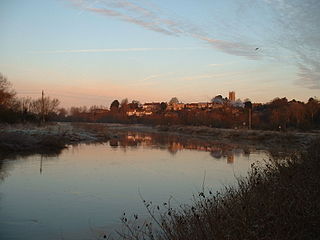
Langport is a small town and civil parish in Somerset, England, 5 miles (8 km) west of Somerton. The parish, which covers only part of the town, has a population of 3,578. Langport is contiguous with Huish Episcopi, a separate parish that includes much of the town's outskirts.

National Provincial Bank was a retail bank which operated in England and Wales. It was created in 1833 as National Provincial Bank of England, and expanded largely by taking over a number of other banks. Following the transformative acquisition of Union Bank of London in 1918, it changed its name to National Provincial and Union Bank of England, then in 1924 shortened its name again to National Provincial Bank. It further acquired Coutts Bank in 1920, Grindlays Bank in 1924, Isle of Man Bank in 1961, District Bank in 1962, thus becoming one of the "Big Five" that dominated the UK banking sector for much of the 20th century, together with Barclays, Lloyds Bank, Midland Bank, and Westminster Bank. On 1 January 1970, it completed its merged with Westminster Bank to form National Westminster Bank.

Westminster Bank was a British retail bank which operated in England and Wales. It was created in 1834 as the London and Westminster Bank. It merged with the London and County Bank in 1909, after which it renamed itself the London County and Westminster Bank, then acquired the former business of Birkbeck Bank in 1911, Ulster Bank in 1917, and Parr's Bank in 1918, following which it changed its name again to London County Westminster and Parrs. It shortened its name to Westminster Bank in 1923.

Warrington Central railway station is one of three main railway stations serving the town of Warrington in Cheshire, England. It is located on the southern route of the Liverpool to Manchester Lines, being situated approximately halfway between the two cities.
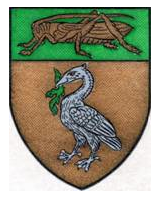
Martins Bank was a London private bank, trading for much of its time under the symbol of “The Grasshopper”, that could trace its origins back to Thomas Gresham and the London goldsmiths, from which it developed into a bank known as Martin's Bank from 1890. That bank was acquired in 1918 by the Bank of Liverpool, which wanted Martins to give it a London presence and a seat on the London Bankers' Clearing House. The Martin name was retained in the title of the enlarged bank which was known as the Bank of Liverpool and Martins Limited. The title was shortened to Martins Bank Limited in 1928 at the insistence of the directors of the Lancashire and Yorkshire Bank when it was bought by the Bank of Liverpool and Martins. The head office and managerial control remained firmly in Liverpool, cementing Martins' place as the only English national bank to have its head office outside London. It was taken over in 1969 by Barclays.
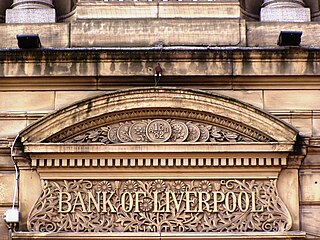
The Bank of Liverpool was a financial institution founded in 1831 in Liverpool, England.
Banking in the United Kingdom can be considered to have started in the Kingdom of England in the 17th century. The first activity in what later came to be known as banking was by goldsmiths who, after the dissolution of English monasteries by Henry VIII, began to accumulate significant stocks of gold.
Joseph Crosfield was a businessman who established a soap and chemical manufacturing business in Warrington, which was in the historic county of Lancashire and is now in the ceremonial county of Cheshire. This business was to become the firm of Joseph Crosfield and Sons.

The Manchester and Liverpool District Bank was formed in 1829 and it became one of the leading provincial joint stock banks; its name was shortened to District Bank in 1924. The Bank was acquired by the National Provincial Bank in 1962 but kept its identity until the latter’s merger with Westminster Bank.
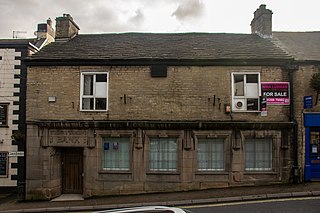
Williams Deacon's Bank was acquired by the Royal Bank of Scotland in 1930. It had a large network of branches in the north-west of England. In 1970, it was integrated with Glyn, Mills & Co. and The National Bank to form Williams & Glyn's Bank.

International Westminster Bank was a wholly-owned subsidiary of National Westminster Bank and its predecessors from 1913 to 1989, with branches in London, France, Spain and West Germany.

William Owen was an English architect who practised in Warrington, which was at that time in Lancashire, England. His works were confined to Northwest England. Owen is best known for his collaboration with William Lever in the creation of the soap-making factory and associated model village at Port Sunlight in the Wirral Peninsula. Here he designed the factory, many of the workers' houses, public buildings and the church. Later Owen was joined by his son, Segar, as a partner. On his own, or in partnership, Owen designed houses, churches, banks, public houses, an infirmary, a school, and a concert hall.
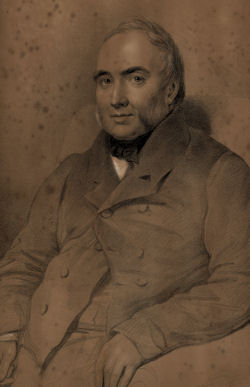
Vincent Stuckey was a merchant and banker of Somerset and Gloucestershire whose note-issue in his heyday was the largest in England and Wales except for the Bank of England itself.
The Capital and Counties Bank was a London clearing bank, which operated 473 branches throughout the United Kingdom from 1877 until its acquisition by Lloyds Bank in 1918.

The Nottingham and Nottinghamshire Bank was a joint stock bank which operated from its headquarters in Nottingham from 1834 to 1919.

The Birmingham Banking Company was a bank that operated in Birmingham, West Midlands from 1829 to 1889, and as The Metropolitan and Birmingham Bank from 1889 to 1892, the Metropolitan, Birmingham and South Wales Bank from 1892 to 1893, and the Metropolitan Bank (of England and Wales) from 1893 to 1914, when it was acquired by the Midland Bank.
Fuller, Banbury, Nix & Co was a British private bank based in the City of London. It was founded in 1737 in Lombard Street, London and operated under a succession of names reflecting its different partners until receiving its final name in 1881. One of the bank's partners, John Hennings Nix, was the second great-grandfather of Alexander Nix. The bank had a seat on the London Bankers' Clearing House. In 1891 the bank was acquired by Parr's Banking Co Ltd of Warrington, thus facilitating the bank's expansion into London. Through merger with London County & Westminster Bank in 1918, it became a constituent part of the modern NatWest.


















